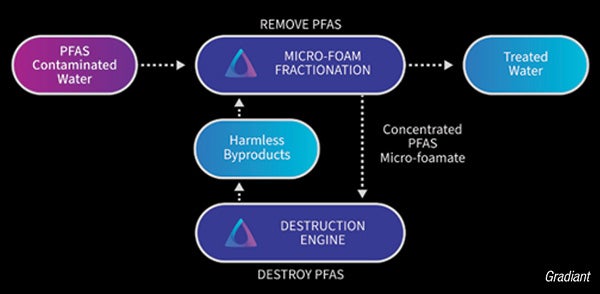Following regulations for drinking water, increasingly stringent limits for per- and polyfluoroalkyl substances (PFAS) in industrial wastewater are anticipated, necessitating improved technology to handle higher rates of removal, as well as to destroy the compounds in concentrated samples.
Gradiant (Boston, Mass.; www.gradiant.com), a global developer of advanced water and wastewater solutions, is answering the call with its PFAS removal and destruction technology, known as ForeverGone. The company has recently commissioned the technology for handling legacy contamination from the fire suppressant AFFF (aqueous film-forming foam) at Munich International Airport.
ForeverGone reduces capital and operational costs with reductions in size of the components and improvements in how the process components work together. The transportable, skid-mounted ForeverGone units combine two technologies, one for separating PFAS and one for destroying it (see diagram). To separate PFAS molecules, the system injects billions of micron-scale bubbles into the contaminated water using a microbubble generator.

“Because of their amphiphilic nature, PFAS molecules are attracted to the air-water interface of the bubbles, where the hydrophobic part of the molecules can face the air in the bubbles, while the hydrophilic parts of the molecule orient toward the water,” explains Steven Lam, head of technology at Gradiant.
The air-water interface “captures” PFAS molecules, and they are carried to the top of the water to form a foam as the bubbles rise. The PFAS-heavy foam is separated from the purified water and collected.
Next, the foam enters an electro-oxidation reactor, in which the PFAS is converted to fluoride ions and carbon dioxide using proprietary electrodes. The system can achieve consistently high (>99.9%) destruction efficiency, Lam says.
ForeverGone units are also equipped with the company’s SmartOps AI platform, a machine-learning system that optimizes energy consumption and allows autonomous operation.
Gradiant is also developing sensors to detect fluoride ions in water to quantify the PFAS collection and destruction onsite, rather than waiting for lab testing, Lam says.